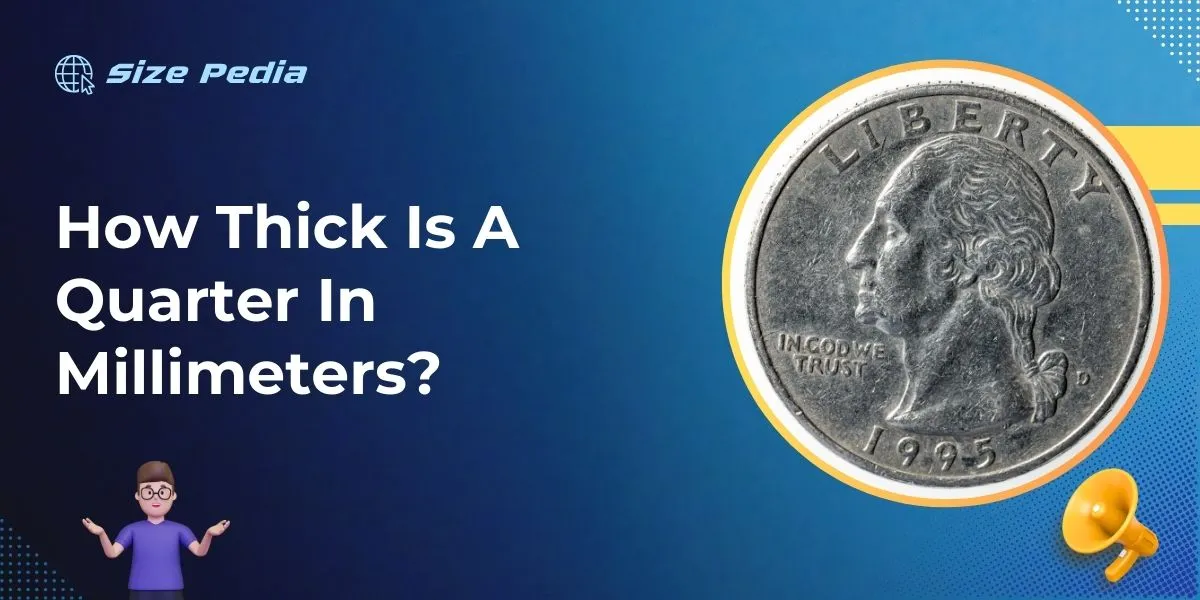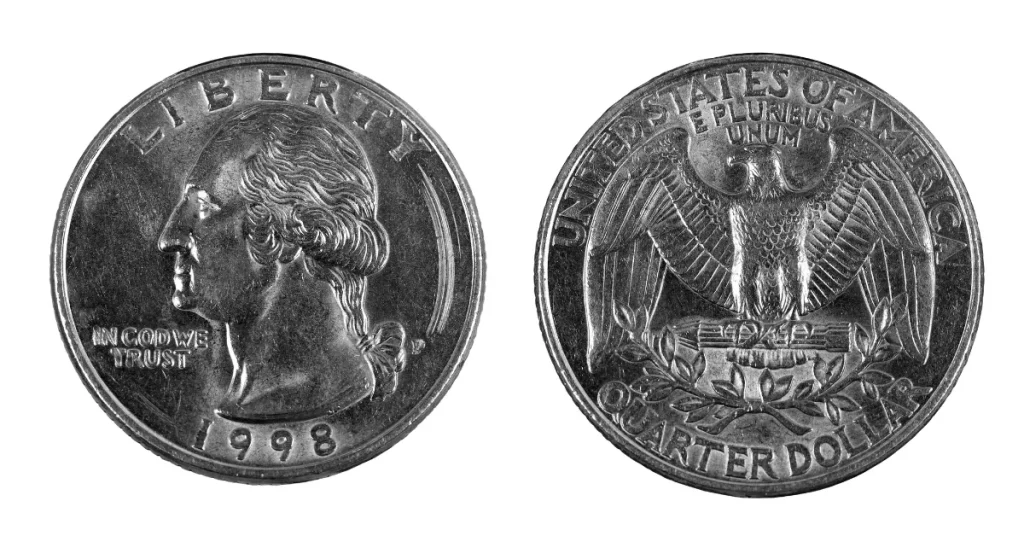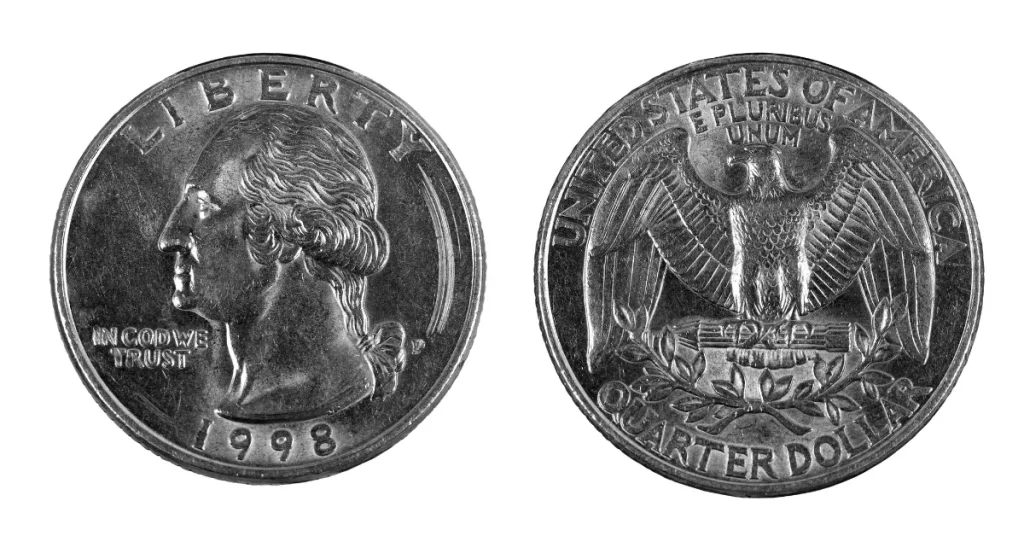A US quarter has a thickness of 1.75 millimeters. This measurement is precise for the currency in circulation.
Collecting coins or simply curious about their specifics, knowing the dimensions of currency is intriguing.
The quarter, officially known as the quarter dollar, stands as a significant piece in American coinage, and its dimensions play a key role in automated payment machines and coin sorting devices.
Precise knowledge of such details is not only helpful for everyday use but also essential for numismatics—the study of coins and currency. The 1. 75 mm thickness is standard for the modern clad quarters that have been produced since 1965.
Understanding these physical attributes aids in authentication processes and helps in recognizing the coin’s compatibility with vending machines and coin-operated apparatuses.
Remembering the exact size of a quarter can be useful for various practical purposes and discussions about American monetary units.

The U.s. Quarter: A Numismatic Staple
The U.S. quarter stands as a cherished piece of Americana. It’s not just a means of currency, but a celebration of culture and history.
Minted to precision, the quarter has size and heft that feel familiar in the palm of a hand. Numismatists and collectors prize quarters for their intricate designs and storied past.
Design And Heritage
Each U.S. quarter tells a story. Through its engravings, it speaks of national pride, iconic landmarks, and significant figures.
- Release date: First circulated in 1796
- Quarter series: Washington, State Quarters, America the Beautiful
- Imagery: Reflects America’s diverse tapestry
These coins carry more than monetary value. They are historic snapshots, small yet mighty keepers of lore and legacy.
Material Composition
Composed primarily of copper and nickel, quarters are built to last. The beauty of these coins strikes a balance between durability and design.
| Material | Percentage |
| Copper | 91.67% |
| Nickel | 8.33% |
The quarter’s composition ensures it can endure daily use while maintaining a quality look. It measures a thickness of 1.75 millimeters, a detail that reflects its lasting presence in pockets and piggy banks.
Standard Dimensions Of A Quarter

Coins tell a tale beyond their monetary value. Attention to the standard dimensions of a quarter reveals precise craftsmanship.
These traits stabilize the currency. Understanding these details can offer insights into coin collecting and everyday transactions.
A quarter has distinct specifications that ensure uniformity and acceptance in machines and by vendors.
Diameter Specifications
The quarter, a mainstay of American pocket change, measures 24.26 millimeters across. To visualize, it’s about the width of a thumb. Quarters before 1965 had a slight variation.
They were slightly different in size. Machines recognize coins using this standard. The diameter is crucial in identifications.
Weight And Thickness
Coins have weight and thickness that guide their usage. A quarter weighs 5.67 grams. It feels light but firm to the touch. The thickness stands at 1.75 millimeters. This sliver of metal is sturdy.
It can survive daily wear and tear. Each quarter uses a blend of copper and nickel. This makes it durable.
Quarter Specifications:
| Feature | Specification |
| Diameter | 24.26 mm |
| Weight | 5.67 g |
| Thickness | 1.75 mm |
- The quarter’s diameter measures just over two centimeters.
- Its weight is slightly more than half a centimeter.
- The thinness is similar to a couple of stacked quarters.
Measuring The Millimeters: Quarter Thickness
Measuring the Millimeters: Quarter Thickness is crucial for coin collectors and industries alike. Coins, while small, have specific dimensions that classify their authenticity and ease their handling.
A United States quarter, familiar to all, has not only a detailed design but also a precise thickness we measure in millimeters.
From Inches To Millimeters: Conversion
A standard US quarter measures 0.069 inches thick. To convert this to millimeters, we use the conversion factor 1 inch equals 25.4 millimeters. Multiplying 0.069 by 25.4 gives us the exact thickness of a quarter in millimeters.
| Inches | Conversion Factor | Millimeters |
| 0.069″ | x 25.4 | 1.75 mm |
Industry Manufacturing Tolerances
Industry standards know coins must fit in machines and stacks. This means there’s little room for error. Quarters come with a manufacturing tolerance. This allows a small difference in thickness, ensuring all quarters are usable.
- Standard Thickness: 1.75 mm
- Manufacturing Tolerance: ±0.08 mm
The Role Of Thickness In Coin Utilities
Coins travel through our hands daily, often unnoticed. Yet, their thickness plays a crucial role in their everyday use.
At 1.75 millimeters thick, a quarter may seem thin, but this precise measurement ensures it fits perfectly in various machines and storage solutions. Let’s explore how a quarter’s thickness influences its practical use in day-to-day activities.
Vending Machines And Coin Slots
Vending machines require coins with specific dimensions to operate correctly. The thickness of a quarter is critical here. It allows the coin to:
- Fall smoothly through the slot.
- Trigger the internal mechanisms that validate authenticity.
- Disengage the product with precision.
Without the correct thickness, the quarter might get stuck or simply rejected by the machine. This ensures a smooth transaction and satisfied customers.
Collectibility And Storage
For coin collectors, the thickness of a quarter isn’t just a measurement; it’s part of what makes a coin special. This dimension:
- Facilitates neat stacking and easy handling.
- Allows for optimal storage in coin folders and albums.
- Helps maintain a coin’s condition and value.
Correct storage is essential for preservation, preventing scratches and exposure to elements that could damage the coin’s surface.
| Coin Feature | Utility |
| Thickness | Ensures proper use in machines and safe storage for collectors. |
Comparing Quarters: Past And Present
Collectors and curious minds often ask, “how thick is a quarter?” It’s a simple question with an interesting answer that shows more than just dimensions, but the story of a nation’s history.
Quarters have evolved over the years, and with them, so have their thicknesses. Below, discover how the size of this coin has changed from past to present.
Historical Changes In Thickness
Early in American history, quarters were not only heavier but also thicker. These coins felt different in the hand, a testament to their unique compositions and the era of their creation. Focusing on thickness, older quarters varied as the U.S. Mint refined its processes.
| Year | Thickness (in millimeters) |
| 1796 – 1838 | 1.8 to 2.0 |
| 1838 – 1964 | 1.75 |
Through different eras, the composition and size saw tweaks due to economics, wartime demands, and technological advances.
Contemporary Quarters

Modern quarters showcase a consistent size and quality not seen in their predecessors. Since 1965, the Cupronickel clad composition was introduced, and with it, a standardized thickness. Today’s quarters maintain a thickness of precisely 1.75 millimeters.
- 1965 – Present: 1.75 mm
Current U.S. quarters are not just tokens of commerce, but also of technological progression. The precision reflects advancements in minting techniques and quality control.
Coin Care: Preserving Quarter Dimensions
Welcome to our dedicated section on Coin Care: Preserving Quarter Dimensions. A United States quarter has a thickness of approximately 1.75 millimeters.
For collectors and enthusiasts, maintaining the pristine condition of a quarter is crucial. This portion of our guide provides insights into safeguarding the integrity of this coin’s thickness and overall dimensions.
Proper Storage Techniques
To keep your quarters in the best shape, follow these storage recommendations:
- Avoid Humidity: Store coins in a dry environment to prevent corrosion.
- Temperature Control: Keep at a stable temperature to deter metal degradation.
- Acid-Free Holders: Use acid-free containers to protect the coin’s surface.
- Individual slots: Place coins in separate compartments to prevent scratches.
Impact Of Wear And Tear
Over time, quarters can suffer from wear and tear. These factors can affect coin thickness:
- Frequent handling leads to surface wear.
- Exposure to elements might cause corrosion.
- Scratching alters the coin’s detailed features.
Maintaining quarters with care ensures their dimensions stay true to their original state.
FAQs About How Thick Is A Quarter In Millimeters
How Thick Is A Quarter In Mm?
A US quarter has a thickness of approximately 1. 75 millimeters.
What Is The Thickness Of A Quarter?
A United States quarter has a thickness of 1. 75 millimeters or 0. 069 inches. This dimension is standardized for circulation.
How Thick Is A 25 Cent Quarter?
A 25 cent quarter has a thickness of approximately 1. 75 millimeters or 0. 069 inches.
Is 1 Mm The Thickness Of A Dime?
A dime’s thickness is slightly less than 1 mm, measuring about 1. 35 millimeters.
Conclusion
Understanding a quarter’s thickness is essential for various purposes, from educational projects to crafting precision.
At 1. 75 millimeters, it represents more than mere currency—it’s a tangible slice of daily measurements. Keep this figure in mind; it’s a quick reference for thickness in a world where details matter.
Resources:
1. https://www.usmint.gov/learn/coin-and-medal-programs/coin-specifications
